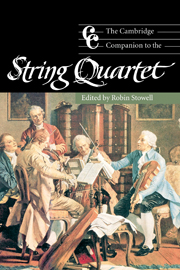Book contents
- Frontmatter
- Part I Social changes and organological developments
- Part II Celebrated ensembles
- Part III Playing string quartets
- 5 Playing quartets: a view from the inside
- 6 Historical awareness in quartet performance
- 7 Extending the technical and expressive frontiers
- Part IV The string quartet repertory
- Notes
- Select bibliography
- Index
5 - Playing quartets: a view from the inside
from Part III - Playing string quartets
Published online by Cambridge University Press: 28 September 2011
- Frontmatter
- Part I Social changes and organological developments
- Part II Celebrated ensembles
- Part III Playing string quartets
- 5 Playing quartets: a view from the inside
- 6 Historical awareness in quartet performance
- 7 Extending the technical and expressive frontiers
- Part IV The string quartet repertory
- Notes
- Select bibliography
- Index
Summary
Introduction
This chapter is not primarily intended as a manual for playing quartets; nor is it a description of what actually transpires in the privacy of any particular rehearsal room. Rather, it aims to describe the main issues which ensembles, in their own way, have to resolve in preparing their performances. After a brief exploration of the notion of a collective interpretation, the main body of the chapter deals with some important aspects of rehearsing, principally in relation to facets of ensemble playing such as voicing, blend, intonation, rhythm, tempo, articulation, phrasing and structure. There follows a discussion of different strategies for coping with residual disagreements, and then some concluding thoughts.
First movement: interpretation
The concept of musical interpretation
Any musician preparing a work of classical music for performance faces the challenge of developing an interpretation which reveals the soul of the work with conviction and freshness. Such a challenge is amplified for a string quartet, because the players have the additional task of reaching their interpretations collectively.
Even without the problem of collective decision-making, what does ‘interpretation’ involve? Just as Shakespeare's The Tempest can seem to be a multitude of extraordinarily different plays in the hands of different theatre companies (especially from various cultures and centuries), so there can be a comparable variety of readings of, say, Mozart's ‘Dissonance’ Quartet (K. 465), even if each group is aiming simply to be ‘true to the score’. This is because it is impossible for a composer to notate for musicians any more precisely than a playwright can for actors.
- Type
- Chapter
- Information
- The Cambridge Companion to the String Quartet , pp. 95 - 126Publisher: Cambridge University PressPrint publication year: 2003
- 1
- Cited by

